Tea drinking in different countries. Tea ceremony
According to the tea ceremony classics, the whole process is guided by four principles:
- Harmony. It is based on the spirit of unity between all parties to the tea party. There are no guests or hosts, all are one and their mood is echoed by the atmosphere that dominates the room.
- Honor, which, in turn, is also divided into two sublevels. The first one is general cultural, that is, each participant in tea drinking respectfully treats his neighbor. And the second is Buddhist. This is an idea of reverence in general, to every person, to every villain, because he is recognized by the Buddha. So those present relate to the tea ceremony with great reverence, often unconscious.
- Purity. Only with pure thoughts and an open heart should we proceed to the tea ceremony. People should be kind in the absolute sense of the word. All participants before the action are washed hands and mouth with water and only then they go where the tea ceremony.
- Rest Only in a calm state of mind, without unnecessary irritability and fuss, all the participants proceed to the tea ceremony.
Over the centuries, the tea ceremony has undergone many changes, but its types have remained unchanged. There are seven of them: the tea ceremony takes place at dawn, in the morning, at noon, at night, with sweets, timeless and for those who came after the main tea party. The ideal is the action, which is arranged in the middle of the day and coincides with lunch.
Tea ceremony rules
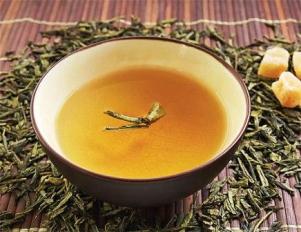
- During the ceremony you need to completely relax. And for a few hours to devote all your thoughts only amber drink. Before you start an action, you must take off your shoes, as it is believed that not only garbage from the street remains with it, but also all its problems and troubles. It is best to sit with tea on the floor, sitting on soft, comfortable pillows. You can sit, you can recline, it does not matter, as long as it is comfortable. This applies only to guests, because the owner of the house will certainly sit and that he honors his guests. He can sit with his legs crossed or his knees up.
- Before the start of tea drinking, it is necessary to get acquainted with tea, to feel the aroma of dried leaves, to do this, pour the leaves into a special box, hold it with both hands, because of the warmth of the body and breath, the aroma of tea is felt better. Still in the box admire the color of tea.
- Dishes must be heated, that is, in turn, pour it with hot water. Water can be kept in a thermos, so it will not cool quickly. The dishes, of course, must not be dirty, but you need to wash them without using detergents, because, settling on the dishes, the chemical elements interrupt the true flavor of the tea. A teapot is better to choose from fine clay, because it contains pores through which clay can pass air. When brewing tea, the essential oil that is in the leaves falls on the wall of the teapot and this kind of film is obtained, which creates a unique microclimate in the teapot. Masters even class teapots into "educated", that is, those that have already been used many times, in which ether film has already been formed, and "ill-bred", that is, completely new dishes. In order for the "ill-mannered" teapot to go to the "well-mannered", it is necessary to brew tea in it and not touch it for seven days, then brew a new tea there and not touch it again for seven days. Either do otherwise: boil black tea and put the kettle in it, and boil it, so the walls are fed.
- For the ceremony, the teapot must be initially heated, then the tea board, on which all elements of the action will be, should be warmed up. Then pour boiling water over a tea pot, cups, and then the rest of the tools. And the water during the ceremony must be shed, and they say that the more water is spilled, the richer the participants will be.
- Pour tea into a heated kettle and pour boiling water over it, then cover it with a lid and pour boiling water over the already closed teapot to warm it up even better. With good warming, tea is brewed better, and also because of this there is no emptiness in the aroma, which may prevent you from enjoying the smell.
- Next, the tea is awakened, for this you need to shake the kettle nine times. So energy is transmitted to tea and it is considered creative and active. And the aroma after such a procedure becomes even brighter. Then it is necessary to pour tea from a teapot into a special vessel, so it is enriched with oxygen and becomes saturated.
- When tea is poured, the vessel is held high to charge the water with positive energy. The first tea poured into high cups, and then low. Further high dishes need to cover the low, so that the male energy flowed into the female. Then take two cups with one hand, while the thumb is located at the bottom and the middle one at the top and sharply turn it over so that the fingers do not burn. This process is a symbol of the union of two principles.
- Then they take a high cup and turn it clockwise and try tea from it. Be sure to do this clockwise, not counterclockwise, otherwise the turn will attract a destructive one. From the high cup they savor the aroma and drink the drink from the low tableware.
- During tea, the first brew is poured, and the second is drunk. This applies to black teas, if you drink, then it is the first tea that is important. It has a delicate taste and aroma. Taking a sip of tea, it is necessary to expand it from the root of the tongue to the tip, since different taste buds are at different ends of the tongue, and in order to fully experience the taste of tea, you need to hold it for some time in your mouth and then swallow it. It is also important to enjoy and aftertaste. Tea can be brewed up to 10 times, the richest aroma will be in the fourth brew.
- After drinking tea, guests admire the tea leaves. And during the ceremony itself, you can even taste the taste of the leaf, but this is optional.
The ban on the ceremony
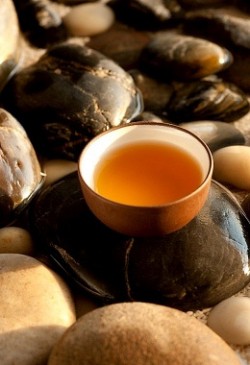
Everything needs to be started with the mind, the same applies to the tea ceremony, it has several prohibitions:
- Do not drink tea on an empty stomach.
- You can not drink burning tea. Long-term use of very hot tea can lead to changes in the internal organs. As scientists say, if you drink tea with a temperature above 62 degrees, you can damage the walls of the stomach.
- You can not drink tea cold. This tea leads to the accumulation of sputum.
- You can not drink strong tea - a large amount of caffeine leads to and.
- Tea can not be brewed for a long time, otherwise you can kill all the healing substances in it.
- Do not get involved in repeated brewing, because after the third brew, beneficial substances it almost does not remain.
- You can not drink tea before meals, otherwise the food will be poorly digested.
- You can not drink tea immediately after eating, during this period will be poorly absorbed protein and iron.
- You can not drink pills with tea, otherwise they will not be absorbed by the body.
- You can not drink tea yesterday, as it divorced organisms.
Of course, such a tea ceremony is not an exact copy of the one that has been passed down from generation to generation for Eastern sages, but the most important thing is to create in your home the very spirit of the tea ceremony and with it will come soulfulness, warmth and desire to enjoy peace.
The tradition of tea drinking has been around for three millennia. Over the years, the drink has gradually turned into a real "hit" on various continents, has become an integral part of different cultures. In each corner of the planet, their own, individual tea ceremonies, characteristic of one or another people, appeared.
Different cultures and countries have developed their own specific tea habits and rituals over the course of a long evolution. Therefore, we can talk about the various national traditions of the use of this perhaps the most famous drink in the world. Who among us has not heard of the famous five o'clock tea in England, the solemn ceremonies of drinking green tea in Japan and China, not to mention the ardent love for tea samovars in Russia!
In this regard, we can recall the additives that are used to enrich the taste and aroma of tea. There are many ways to prepare and drink. Depending on the culture and traditions, they drink it hot or cold, with milk, lemon, sugar, rum, and even with salt and butter. Let's see what interesting ways they prepare and consume tea in different countries of the world.
China and Japan
In China and Japan, the tea ceremony is, above all, relaxation and contemplation. There it is not customary to drink tea in a hurry or while eating. In China, it is brewed in a small covered vessel. On average, this process takes 2-3 minutes, then the infusion is poured into cups, leaving the tea leaf in the tea pot. It is believed that the best drink is obtained after the second brew.
The Chinese usually drink unsweetened with the addition of jasmine, orange, magnolia or lotus. For its preparation use spring water. Sip tea in small sips.
 In Japan, tea drinking is held in special pavilions and is an extremely complex ceremony, which is called ga-no-yu and is prepared by geishas. Like the Chinese, the Japanese drink tea leisurely, in small sips.
In Japan, tea drinking is held in special pavilions and is an extremely complex ceremony, which is called ga-no-yu and is prepared by geishas. Like the Chinese, the Japanese drink tea leisurely, in small sips.
England
The British, like the inhabitants of distant Asia, created their own, special culture of cooking and drinking tea. They serve tea in the kettle. It is prepared as follows: tea leaves are poured into a heated and dry vessel, filled with boiling water and kept for five minutes. Then the tea is poured into small cups with a small amount of milk and sugar is added.
The British drink it three times a day: in the morning, during lunch, and, of course, at five o'clock in the evening they have the famous five o`clock. At the time, it is accepted to slowly sip the drink with barely parted lips.
Russia
In Russia, they drink black tea, strong and very hot. Strong tea brew was formerly diluted with water from a samovar, in which water retains a very high temperature for a long time. According to Russian tradition, tea is drunk long and slowly, usually from cups. Gorky tea is drunk with pieces of sugar or jam, which is served in small vases.
Arab countries
Arabs drink tea from small cups, expanding upwards. The preparation of the drink involved men; as a rule, this is the head of the family. At the bottom of the metal kettle pour some green tea and pour it with a small amount of boiling water to get rid of the bitterness of the leaves. Then the water is drained. After that, crushed mint leaves and a large lump of sugar are added to the jar, poured with water and set on fire.
When the water begins to boil, the kettle is left for 5 minutes and then the tea is poured several times from the jug into the china and back. According to Arab tradition, tea treats testify to hospitality, respect for visitors. Arabs drink only green teabecause religion forbids them to use fermented beverages.
Tibet
Perhaps the most interesting for us Europeans is the way of making tea in Tibet. There, tea looks more like broth than the traditional brew to which we are all accustomed. In these parts, the drink is made from strong brewed green tea, salt and butter, made from yak milk. Very hot mixture is whipped for a long time until it turns into a homogeneous mass. The beverage thus prepared has excellent warming properties.
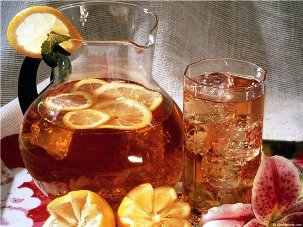 United States
United States
The United States is the birthplace of iced tea, the so-called ICE TEA, and tea bags. Ideas to use chilled tea and prepare it in an express way were born at the beginning of the 20th century, during the World Exhibition in St. Louis. One of the producers of tea had the idea to offer their drink to visitors at the event. A huge amount of tea was brewed for them, but since it was hot, warm drink was not a great success on this day. In order not to lose the money invested, the manufacturer added a large number of ice cubes to the tea. The result was a sensation, rumors of which quickly reached other countries.
Something similar happened with tea bags. One New York vendor wondered how to distribute tea samples to customers. Each sample was packed very carefully, so that the tea leaves did not wake up. After some time, he noticed that customers threw bags of tea bags into the teapot without removing tea leaves from there. It turned out that they did this so as not to scatter tea in the kitchen. The seller from New York decided to take practical advantage of his observations and began to make the first tea bags. As we see, in this case the invention that we use to this day came to light because of the need to get out of a difficult situation.
The traditions of making and drinking tea are very diverse, rich in variations of taste and smell. Thanks to the opportunity to quickly and easily get to the most remote corners of the planet, we, the inhabitants of the old woman of Europe, can also enjoy them without leaving our own home.
The tea ceremony is the process of making a tea drink and using it as a ritual. It is not just brewing and tea drinking - it is a kind of meditation, enjoying every moment, searching for inner harmony, getting to know the aroma and taste of tea.
Contrary to popular belief, popular not only in and. The culture of tea drinking existed in ancient England and in Russia, as well as in other countries. Each of these countries introduced something that other nations do not have to the process of brewing and drinking tea. And in each country the ceremony is interesting in its own way.
The process of tea drinking in Russia
In Russia, it appeared only in the XVII century, and for a long time it was used exclusively as a healing tool. Tea culture began to develop at the end of the 18th century - thanks to the creation of railways. Tea traditions received even more powerful impetus after the invention by the Lisitsyn brothers, a samovar - the traditional Russian tea-drinking tool.
Tea houses began to open actively, dry tea leaves became much cheaper and began to be sold at fairs. gradually "crept" in ordinary homes. At this time, the rules of tea etiquette were born, and with them the traditional Russian invitation “for tea”.
Russian is called "Merchant" and for it are used:
- strong infusion of tea in the teapot;
- hot water samovar;
- traditional Russian dishes: cups, saucers, glass holders, pie plates and dessert spoons;
- lump sugar;
- butter products: donuts, pies, cheesecakes, rolls, etc .;
- other sweets: jam, honey.
It is important! It was necessary to drink tea hot, pouring small portions into saucers. The saucer was supposed to take with one hand, and pull the tea with his lips. This process was accompanied by a characteristic sound, and it was believed that the louder it was, the more enjoyment a person received from the tea ceremony. Sugar was not added to the drink, as it is now, but was eaten with the drink.
Merchants in Moscow and St. Petersburg held a ceremony with a special scale. Tea-drinking could last up to several hours, and guests were invited to it. According to tradition, at the end of tea drinking, it was decided to turn the cup upside down and put the remaining sugar on it. This meant that the person got drunk and enjoyed the ceremony.
Traditions of England
The English tea ceremony originates from the famous tradition of afternoon tea and is mainly held in the evening. Despite the fact that the modern fast rhythm of life has transformed or erased altogether many rules of tea drinking, in some families and institutions the tea ceremony still remained.
The British are a strict nation, and prefer aesthetics in everything, including during tea drinking. For the ceremony will need:
- tablecloth;
- napkins;
- teapot;
- vase with fresh flowers;
- cutlery: fork, knife, dessert spoons;
- cups;
- milk jug with cream or milk;
- strainer;
- bakery products;
- refined sugar.
Tablecloth and napkins must be in harmony with each other, and their color should be light. Ideally - white. Dishes strictly belongs to one service. Porcelain sets are considered to be a sign of prosperity. Shades of dishes are preferred from to blue.
It is important! Brewed drink in such a way that hot water will not be added to spilled tea. Therefore, a teaspoon of tea leaves per person is put in the kettle.
If the kettle is large, it is additionally desirable to add another spoon of tea leaves. Insist drink traditionally 3-4 minutes, and then poured into cups. Boiling water is added to the kettle again so that the drink is brewed. And the kettle itself is covered with a special cover so as not to cool. More than 2-3 times usually tea from one brew is not prepared - the drink loses its taste and aroma.
For tea in England they serve pastries: jam, tikake - a bun with raisins, waffles, ginger cake, pastries. Of course, if you wish to have an English tea party, it is not necessary to prepare these desserts - they are somewhat unusual for Russian tea lovers. But a simple cake will be a great addition to the tea ceremony.
How to drink tea in Korea
AT different countries tea ceremonies are held in different ways, but they are united by one thing - love for tea and a relaxed atmosphere during this process. The process of drinking tea in Korea is not just a ritual - it is a religious act. In Korea, tea appeared thanks to the monks, so tea is closely associated with the Buddha.
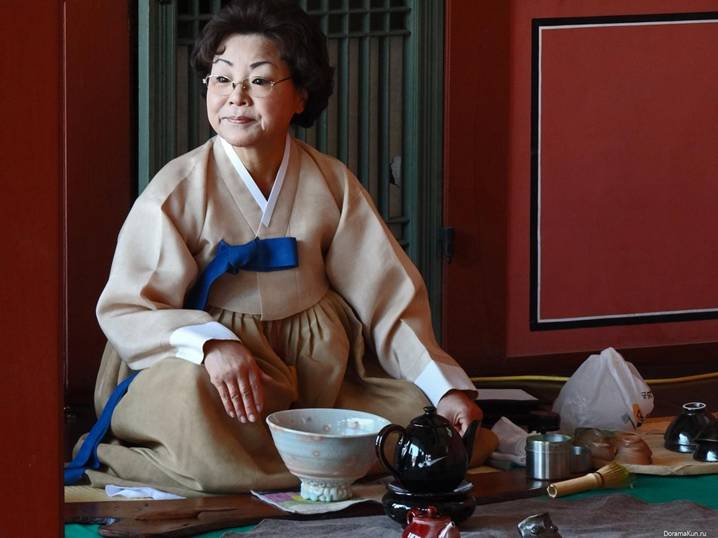
For tea drinking you will need:
- teapot;
- brewing container;
- a large cup;
- a cup with a beak;
- low table;
- tableware: wooden plates, spoons;
- cups;
- napkins.
Drink a drink from Koreans taken on the rug, sitting at a low table. They usually sit on their knees, with an emphasis on the heels. Before the start of tea drinking, it is customary to cover the dishes with napkins. The traditional location of the guests - facing the sunrise, to the west, the host or the one who conducts the ceremony, faces east.
Azerbaijan: tea for a friendly conversation
No significant event in Azerbaijan is complete without tea. This drink has become a must, not only on ordinary days, but also on holidays.
For the tea ceremony, you will need a special glass - “armuds”, i.e. "Pear-shaped". To understand why this dish so called, just look at the photo - the unusual shape of the glass really looks like a pear. It is not only convenient to hold the armuds in your hands, but the drink in it cools down much more slowly.
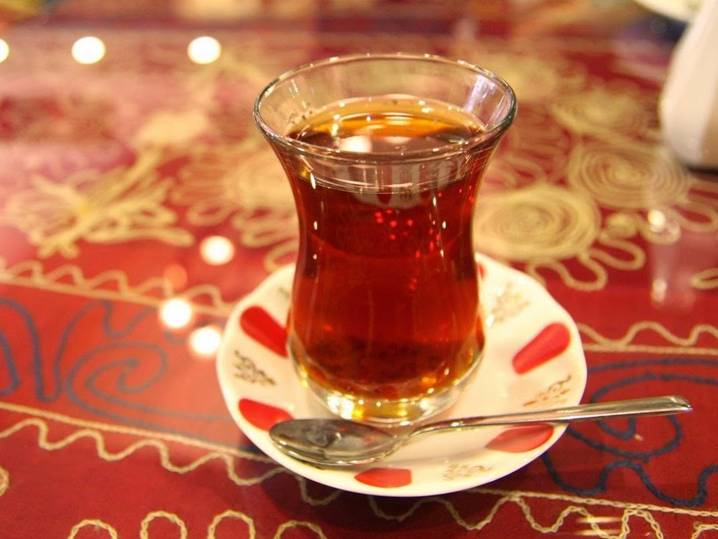
As a snack for tea favorite Azerbaijani delicacies:
- lump sugar;
- candy sugar with walnuts;
- turkish Delight;
- baklava;
- nuts.
With the tradition of tea ceremonies are closely related special institutions - teahouses. If in other Asian countries tea houses serve not only tea, but also food, in Azerbaijan it is customary to use only tea with sweets. Only men go to institutions of this kind. Over a glass of tea, various events and affairs are discussed here, friendly conversations are held, old times are remembered, and quarrels are reconciled.
Tea traditions of Thailand
In Thailand, tea is revered no less than in other countries. It has its own rules and customs associated with tea drinking. Drink be sure to drink in a peaceful atmosphere - this is achieved by a harmonious and calm decoration of the interior.
The teapot - the harbor - is a family relic. It is passed from generation to generation, taking care and protecting it from damage and dust. An interesting process of brewing a drink and preparing for its use can be viewed at video.
In Thailand, there is a special kind of tea - blue. It is often used during such ceremonies. But from the point of view of science, this is not tea at all - for the preparation of a drink they use the Clitoria ternary plant. But Thai people really appreciate and respect this drink, often replacing them with tea. Drinking tea in Thailand is not only hot - a cold drink is very popular, especially during the warm season. Cane sugar is used as an additive.
Tea ceremony at home
If you want to immerse yourself in a tea culture of one of those countries where they love this drink for a few hours, you should think about how to spend at home. This is an excellent tool for meditation, relaxation and just relaxing in the company of friends and loved ones.
Each of the countries has its own peculiarities in the conduct of tea drinking, so all the rules and subtleties will have to be familiarized in advance.
The first thing you need is dishes. For fans of dishes. These kits are sold in online stores and special departments. But if tea is planned for one time, it is better to do with what is at home. What items you need, you can see in the list of dishes used in ceremonies in each of the countries.
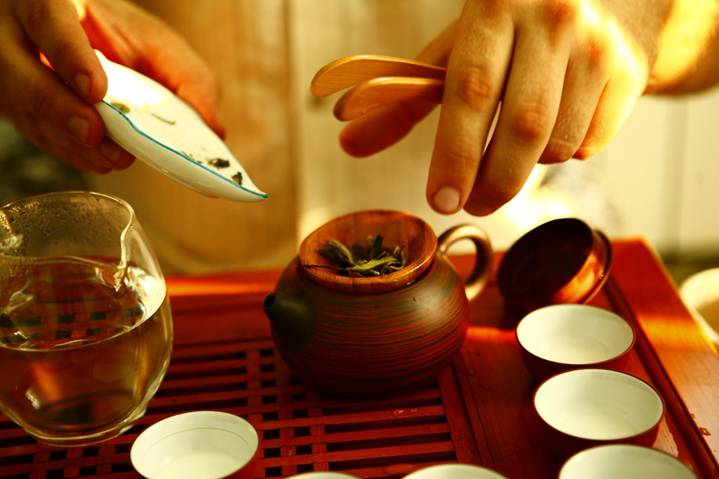
Another important component of tea drinking is the environment. For the full immersion, a thematic design of the place where the event will take place is created, and clothing is also selected. Inviting guests or enjoying tea by yourself is a matter of everyone’s choice.
- the heritage of those countries that managed to create these traditions, to make them permanent and not to lose them over the past centuries. And it is not necessary to be a representative of the country whose ceremony I would like to hold. For just one day, you can be reincarnated as an Englishman, and try out all the subtleties of the mystery of making tea and using it in any of the countries.
Japan is a country of amazing traditions, culinary masterpieces that delight tourists from all over the world. One of the most fascinating features of this culture is the Japanese tea ceremony. This is the real art of making and drinking tea, a beautiful ritual that you must see at least once in your life. The tea ceremony in Japan has become a part of life, a tradition that was founded in ancient times, but survived to the present day. Therefore, it attracts those who wish to touch one of the most valuable rituals of this country.
A bit of history
The history of the tea ceremony dates back to the Middle Ages. Tea appeared in Japan in the eighth century. It is believed that brought him Buddhist monks or travelers. Tea was grown on the territory of the monastery and presented to the Buddha. It was used during meditations and religious events. It was Buddhist priests who started the traditions of the tea ceremony in Japan. Began to hold tournaments for guessing the best varieties of this drink. Among ordinary people, tea meetings were held at which they tried to learn the aesthetics of this process. The tea ceremony itself was invented by Murat Jyuko. He added philosophy and sign language to this art. These were attempts to get away from worldly vanity to peace and quiet.
Ritual features
The Japanese tea ceremony is not just a technology for making and drinking tea. This is a set of components that must accompany this ritual. The tea house for the ceremony, according to the idea of the founders, was to be a small peasant hut with a thatched roof. It was later improved by the followers of the teaching. The art of the tea ceremony in Japan involves the use of special ceramic tableware made by local craftsmen. 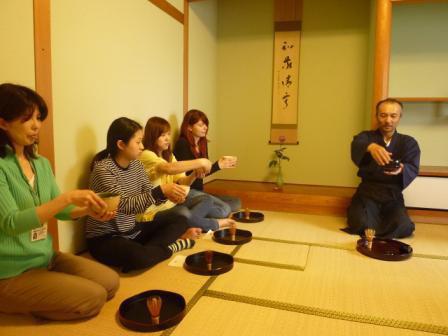 Around the tea house there is a garden created according to certain principles. Etiquette was also developed for the participants in the ceremony, the topics and the nature of the conversations, which should be relaxed and create an atmosphere of peace and detachment. A stone path leads to the tea house. Around there are a lot of mossy stones and lanterns. The garden is dominated by cypresses, evergreen shrubs, pines and bamboo. Everything should bring thoughts of detachment and tranquility.
Around the tea house there is a garden created according to certain principles. Etiquette was also developed for the participants in the ceremony, the topics and the nature of the conversations, which should be relaxed and create an atmosphere of peace and detachment. A stone path leads to the tea house. Around there are a lot of mossy stones and lanterns. The garden is dominated by cypresses, evergreen shrubs, pines and bamboo. Everything should bring thoughts of detachment and tranquility.
Tea house
This is one of the important elements of the ceremony. The house consisted of one small room. The door was a narrow entrance of no more than 60 centimeters in height and width. One of the principles of the ritual involves the equality of all incoming, and everyone must bend when entering, regardless of position. Such an entrance did not allow weapons to be brought into the house, and all swords remained outside. Inside there is no place for worldly bustle, everything is beautiful here.  The main component of the building is a niche, where there is a scroll with paintings, an incense-burner and a bouquet of flowers. This niche is located opposite the entrance and immediately attracts attention. Multiple windows of different sizes allow light to penetrate just enough to provide optimal lighting. Through them you can admire the beauty of the garden.
The main component of the building is a niche, where there is a scroll with paintings, an incense-burner and a bouquet of flowers. This niche is located opposite the entrance and immediately attracts attention. Multiple windows of different sizes allow light to penetrate just enough to provide optimal lighting. Through them you can admire the beauty of the garden.
Ritual development
Every year the sequence of actions and behaviors became improved. Going into limits tea garden, guests plunged into the atmosphere of peace and tranquility, leaving all the problems outside the gate. Before entering the house it is customary to take off your shoes and leave them at the door. In complete silence, everyone enters and sits down, penetrating the silence and beauty of the attributes. After some time, the master of the ceremony comes out and, bowing to the guests, sits opposite, near the hearth.
Tea Attributes
The tea ceremony in Japan is an unhurried ritual that helps you relax and indulge in meditation. For its implementation using special objects - real works of art. The main accessories are: a tea box, a wooden spoon and a cup. Above the fire hanging pot of water. Each item has a certain aesthetic and philosophical value. This is not just a ritual - it is the principles, the comprehension of the great meaning of life. Therefore, all attributes are important.
Tea ceremony
The master of the ceremony should pour green tea into a cup and pour boiling water over it. All gestures must be leisurely, without fuss. Then, with precise movements, the mass is whipped with a bamboo whisk. Tea powder should completely dissolve and turn into foam. All this time, guests watch the process and listen to the rhythmic movements. Next, the cup is passed to the guest of honor, and he takes the first drink, sipping tea. Everything is done slowly, without disturbing the general calm. 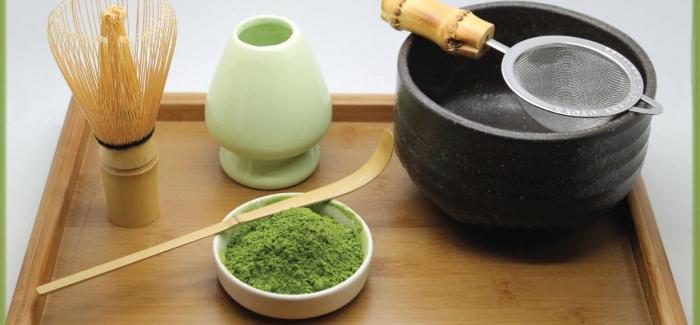 Then the bowl is given back to the master of the ceremony. After that, it is passed from hand to hand, so that each participant can feel the structure and warmth of the clay surface. Next began a leisurely conversation. It was necessary to speak about the beauty of the scroll and the bouquet, located in a niche, about the properties of the cup for tea drinking. Problems and daily affairs remain outside the tea house and garden. The whole ceremony takes place in three stages. The first is eating. This is followed by drinking thick tea, that is, the ritual described above. Then comes the drink of liquid tea.
Then the bowl is given back to the master of the ceremony. After that, it is passed from hand to hand, so that each participant can feel the structure and warmth of the clay surface. Next began a leisurely conversation. It was necessary to speak about the beauty of the scroll and the bouquet, located in a niche, about the properties of the cup for tea drinking. Problems and daily affairs remain outside the tea house and garden. The whole ceremony takes place in three stages. The first is eating. This is followed by drinking thick tea, that is, the ritual described above. Then comes the drink of liquid tea.
Principles of Ceremony
The tea ceremony in Japan has four basic principles. They were formulated by the founder, Murat Dzuko. The first principle is harmony (“va”). It must be present in the movements and thoughts. The second is the reverence (“kei”) that accompanies the entire ceremony. 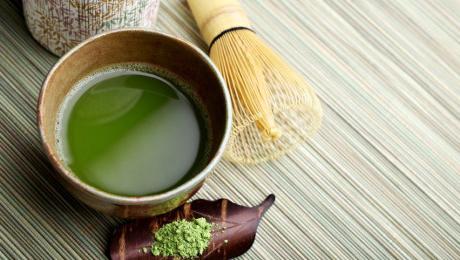 The third principle is purity (“sei”) of actions and thoughts. The last is peace and quiet (“seki”). The tea ceremony in Japan is held in silence, tranquil atmosphere, where nothing disrupts the steady flow of life. Peace and quiet imply enlightened loneliness.
The third principle is purity (“sei”) of actions and thoughts. The last is peace and quiet (“seki”). The tea ceremony in Japan is held in silence, tranquil atmosphere, where nothing disrupts the steady flow of life. Peace and quiet imply enlightened loneliness.
Principle of harmony
The most important goal of any tea ceremony is to achieve harmony. Participants must abandon earthly problems, worries and thoughts. During the ceremony there are no differences between people and their origins. Everything is united, and harmony is achieved. This is the basis and the whole culture of this country. Harmony of thoughts, not related to everyday difficulties. Participants talk about beauty, things related to the ceremony itself, and achieve unity in their desires, actions and thoughts. This is the purpose and meaning of such events.
Principle of worship
This principle is based on tolerance and respect towards the older generation or to other participants in the ceremony. It lies in the basis of education, which is vaccinated to the Japanese from childhood. Therefore, in this country, the level of honoring the elderly, senior in rank and age is the highest. Ritual participants must control their feelings and feelings and be tactful towards other people sitting in the tea house.
Principle of cleanliness
This principle implies mental and physical purity. The intentions of each participant should be the lightest. There should be no evil or selfish intentions. Participants must be pure in spirit and body. According to beliefs, such people will have good health and many benefits.
The principle of peace and quiet
The latter principle implies complete peace of mind and peace. Each guest should calmly accept the entire ceremony, with restraint and without irritation. The tea ceremony, the photo of which will leave the best memories, was created to bring people together and bring them to peace and tranquility. During the ritual a friendly atmosphere is maintained, a polite and tactful attitude between all participants.
Guest Choice
The master of the ceremony is engaged in the selection of guests. The most important thing for him is the definition of the most honorable participant. This person should know the traditions of the tea ceremony and all the rules for its conduct. The main guest is an example for other participants. 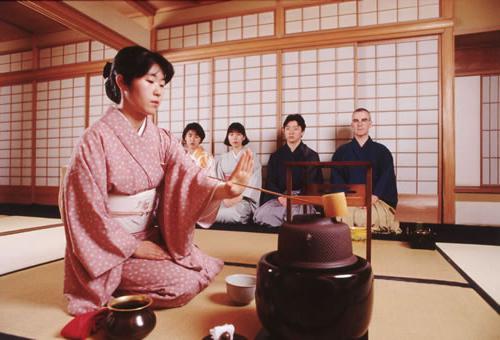 He is informed about the ceremony at least a week. After that, he gives his consent or refuses to participate in this action. The main guest, along with the host is engaged in the selection of other participants. The organizer of the ceremony sends him a list from which to select five people, or discuss this issue in person. When participants are selected, invitations are sent to everyone. Today, for these purposes use the phone. Previously, everything was much more complicated and more elegant. In response, each guest was obliged to personally visit the organizer of the holiday or send him a letter with gratitude.
He is informed about the ceremony at least a week. After that, he gives his consent or refuses to participate in this action. The main guest, along with the host is engaged in the selection of other participants. The organizer of the ceremony sends him a list from which to select five people, or discuss this issue in person. When participants are selected, invitations are sent to everyone. Today, for these purposes use the phone. Previously, everything was much more complicated and more elegant. In response, each guest was obliged to personally visit the organizer of the holiday or send him a letter with gratitude.
Tea Ceremony Clothing
Clothing for this ritual is selected depending on the type of event. For a formal celebration, men wear silk kimonos. Over it there is a black cape with the drawn white sign. They also wear wide trousers (hakamu) and a white belt (tabi). Requirements for women's clothing more stringent. The main one is modesty clothes. It should not be bright and challenging colors. Ceremony participants usually bring napkins with them. They need to be put behind the kimono cuff. They should also have a small and large shawl and a pointed wooden stick. These are necessary for carrying out accessories.
Varieties of Tea Ceremony
The tea ceremony, the photo of which can be seen in this article, is subdivided into six types. The ceremony performed under the moon ends no later than four in the morning. Powdered tea is brewed during the tea itself. He must be very strong. The ritual performed at sunrise ends no later than six in the morning. There is a morning tea ceremony in Japan. In short - this tea after six in the morning. 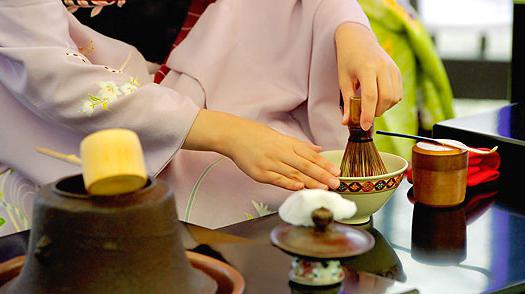 Afternoon ritual is performed after one o'clock in the afternoon. From the food here they serve only cakes. At six o'clock in the evening they begin the evening ceremony. There is also a special ceremony, which is held on special occasions. For example, in honor of some memorable event. The most common is the afternoon ceremony. Each ritual has its own characteristics. They are not noticeable for the average man in the street, but connoisseurs feel the subtle nuances of various ceremonies.
Afternoon ritual is performed after one o'clock in the afternoon. From the food here they serve only cakes. At six o'clock in the evening they begin the evening ceremony. There is also a special ceremony, which is held on special occasions. For example, in honor of some memorable event. The most common is the afternoon ceremony. Each ritual has its own characteristics. They are not noticeable for the average man in the street, but connoisseurs feel the subtle nuances of various ceremonies.
Ceremony tea
Separately, it should be said about tea, which is used for tea events. In addition to dishes, furnishings, participants, the main component of the entire ritual is tea. It was originally shipped from China. Over time, the Japanese learned to cultivate and grow their varieties of tea. Their difference from the drink of Chinese, Indian or Ceylon origin is very significant. Therefore, for this ceremony, you should choose only tea grown in this country. This is how the tea ceremony in Japan takes place, the photos of which make you want to visit this event. But it is best to see this ritual in reality and experience all its beauty and harmony.
In the lives of Chinese people, tea stands in a special place, and drinking tea has become a separate art of the tea ceremony.
The Chinese prefer tea to other drinks even in the summer: it not only quenches thirst, but also contributes to an increase in immunity.
Tea Ceremony in China - A Little History
The appearance of tea is attributed to one of the main figures to the divine progenitor of all Chinese people, Shen Nunu, whose name in Chinese means "Divine Plowman". It was this hero who taught the people to plow the land, grow cereal crops, as well as medicinal and other useful plants.
The legend says that Shen Nong had a bull head and a human body, while his stomach was made of transparent jade. Shen Noon helped people to cure illnesses, and for this he wandered around the country in search of medicinal plantsby separating them from common poisonous ones. The healer checked the effect of the herbs found on himself. At the same time, he observed the effect of the eaten plant or its fruits on the body through its transparent belly. It is said that once he tried a new, unfamiliar plant and as a result received a strong poisoning. When he felt very bad, he lay down under an unfamiliar bush. Suddenly a dewdrop rolled from the leaves of the bush. Swallowing this drop, the doctor felt a surge of strength and pleasant vigor throughout his body.
Since then, Shen Nun has carried the leaves of this plant with him everywhere, using them as an antidote. So it happened that he taught all Chinese people to drink tea as a medicine.
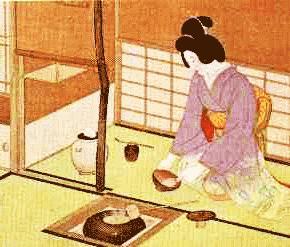
In ancient times, tea was a drink for rich people. No one knows exactly when he switched to the daily drink. At the same time, in the 1st century BC, tea was widely distributed, and it was already available on the market. And from 618 to 907, the Chinese tea ceremony began to develop, and for the first time tea
Over time, the Great Silk Road tea penetrated into Russia. In the literature it is reported that the Cossacks presented tea to the Russian Tsar in 1567 as a gift. Truly Russians were able to appreciate the fragrant drink in the 19th century. It was then that formed the Russian tea ceremony. They learned how to brew in world famous Russian samovars.
In China, the tea ceremony is a ritual where a certain order is observed when brewing a drink. The main purpose of this action is to disclose the taste and aroma of tea, and the rush is inappropriate here. Chinese tea ceremony implies calm and tranquility. Fancy objects of tea utensils, exquisite dishes of small size, as well as pleasant soft music help to create a special atmosphere - thanks to all these factors, it becomes possible to enjoy the unforgettable aroma of tea drink and long aftertaste known all over the world.
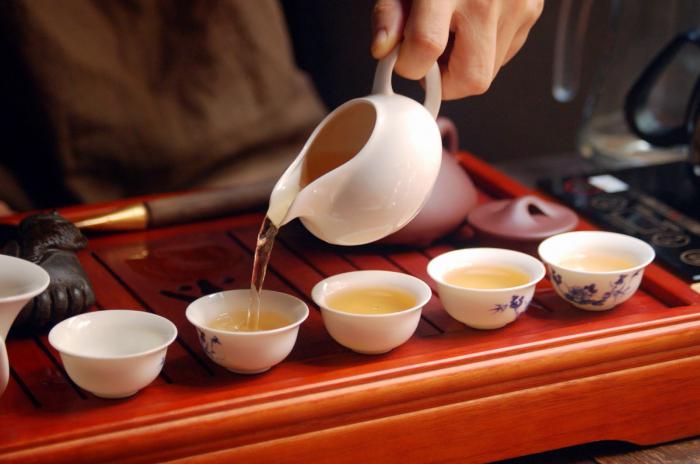
Features of the tea ritual in Chinese
The tea ceremony in China is called gungfu-cha: gung is the highest art, and cha is, of course, tea. The Chinese themselves attach particular importance to the ritual. They have this skill, which not everyone can master.
Chinese tea ritual is considered one of the most mysterious and mysterious in the world. Perhaps this is explained by the fact that the Chinese consider tea not just a drink. For them, tea is a wise plant, which is given to transmit the energy of life. To obtain this energy there are certain conditions that are summarized in the rules of the ceremony of tea drinking.
Special requirements for water
The choice of water, which will brew tea, is crucial. It must be from a clean source. The most suitable is the one that has a sweetish taste and soft structure.
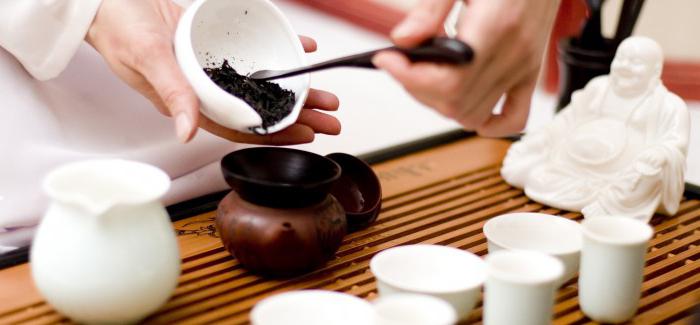
When making tea, boiling water is important. It does not need to bring to a strong boil, because of this because it leaves its own energy. They say that the water is considered to boil to the desired state of tea, as soon as bubbles appear in it - they do not allow it to boil violently.
Sounds of music
Traditionally, before the start of the ceremony, a person must be cleansed, to reach a state of inner harmony and peace. That is why it takes place in a beautiful room and to the sound of pleasant music, often fascinating and mystical. For the best effect, the tea ceremony master prefers to use the sounds of nature. This contributes to the immersion of man in the depths of his soul and helps to better merge with nature.
What do they say at the tea ceremony?
During the tea ritual traditionally they talk about the tea itself. In addition, an important element of the ceremony is to demonstrate respect for the tea deity and talk about it. Often the master put his statuette or image next to the tea utensils.
The internal state of the audience
According to all canons, the ritual takes place in an atmosphere of goodness and harmony. In the process of tea drinking, it is not customary to talk loudly, wave your arms or make noise. To feel the true pleasure from the drink and true happiness helps complete concentration.
By the way, the tea ceremony in China involves from 2 to 6 people. It is in this case that an amazing atmosphere can be achieved, which is traditionally called the contact of souls.
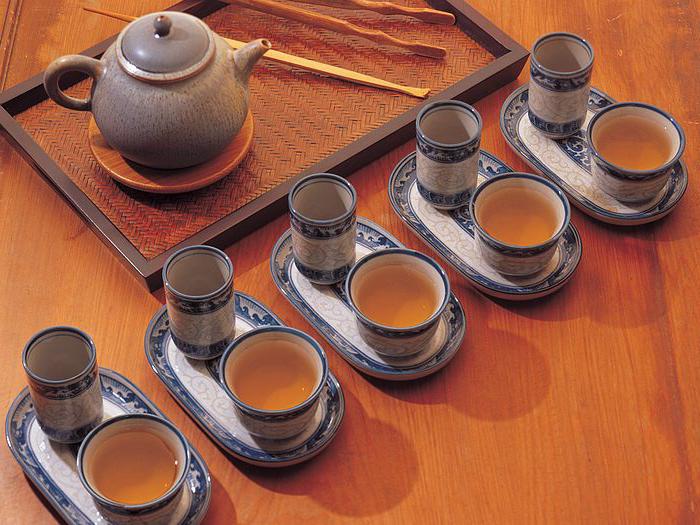
Tea Ceremony Interior
All those present sit on straw mats on the floor. Around the guests lay soft cushions of a pleasant warm color. In the middle of the table is set for tea, called chaban, about 10 cm high. It looks like a kind of wooden box. There are special holes in it, where the remnants of tea are poured, because in China, excess water speaks about abundance.
When all the basic principles of tea drinking are observed, the solemn moment of the tea drinking itself comes.
So, Chinese tea
The set for the tea ceremony is laid out in front of the guests. Dishes include: a teapot for brewing, a jar — a tea cup, a tea box, called tea cup, and a pair of tea. All utensils for the tea ceremony should be made in the same style and not distract by their appearance from the wonderful drink.
First of all, the master pours dry tea brew in a tea cup - a special porcelain box, which is designed to study the structure of tea and inhale its smell. All participants slowly pass it into the hands of each other and inhale the aroma. This ritual has one more meaning - during the transmission of cha-he, those present approach each other.
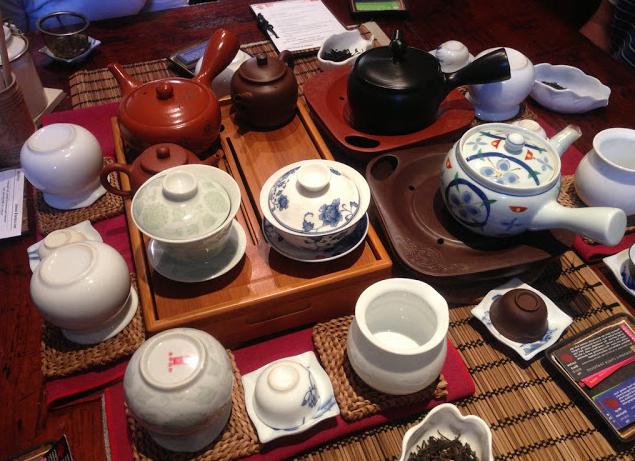
After that, the master of gongfu-cha brews tea. The first poured boiling water is drained - this way the dust from the tea is washed off. But from the next pouring, each guest of the ceremony enjoys a miraculous drink.
Before each participant is on a tray. These are two cups, one of which is high and narrow (venxabei), designed to perceive the smell, and wide and low (chabei) - to enjoy the color and taste of tea. Second water is poured into tall cups after she has been in the teapot for about 30 seconds. Wenxabei is filled with only ¾ and immediately covered with a wide cup. After a while, the top cup is removed and, bringing the bottom cup to the nose, inhale the wonderful aroma of the resulting tea. It is important to concentrate and merge with the energy of tea. Tea is drunk slowly, focusing on sensations.
Tea is poured until the beverage has color and aroma. With each new pouring, the tea gets different shades of smell and taste.
As a result, the tea ceremony gives peace, peace of mind and helps to forget about the hustle and bustle of our lives.
Tea Ceremony in England
The UK is one of the world leaders in tea consumption per person. Tea drinking for the English is not just a ritual with its established traditions. He came from the English tea-drinking Five-o-clock Tea.
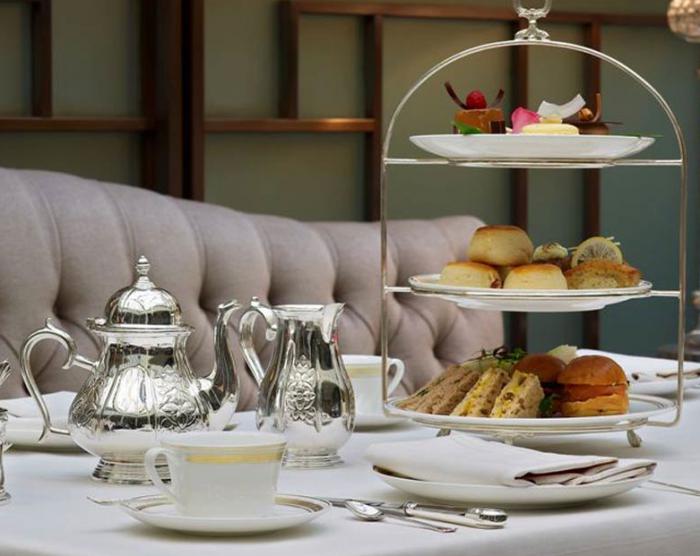
The traditional English tea ceremony set is a white or blue tablecloth without drawings, a vase with lively white flowers. Tea pairs, with tea, milk jug, jug with milk, strainer and stand for it. In addition, you will need a sugar bowl (preferably with white and brown sugar), teaspoons, a fork and a knife, napkins to match the tablecloth.
For tea, snacks are always served - these are various English pastries. Traditionally, guests can choose among 5-10 varieties of tea, where Lapsang Souchong, Earl Gray, Darjeeling, Assam, as well as various tea blends are mandatory.
By the way, another important element of serving is a quilted or woolen bag on a teapot (tea-cozy).
The tea ceremony in England has a secret. When brewing tea, it is taken into account that it will no longer be diluted in boiling cups. This means that when brewing, tea leaves are placed in a kettle, based on the fact that there is 1 teaspoon of tea per person. In the case when using a large teapot, it is recommended to add another 1 spoon to all.
Then 3-5 minutes the tea is infused, and it is poured to guests. Immediately thereafter, it is necessary to pour boiling water from a jug into the kettle (a feature of the tea ceremony is to re-fill the tea leaves) and cover it with tea-cozy to keep the temperature. By the time you finish drinking the first cup, the second pour has time to infuse. The kettle can be poured again, but each time the quality of the drink will deteriorate.
Traditionally, tea is drunk with milk, and tea is added to hot milk, and not the other way round.
Russian tea traditions
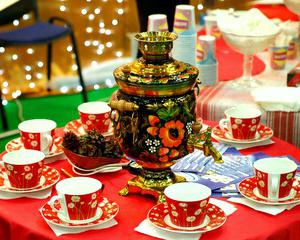
The tea ceremony in Moscow is a completely different tradition, very different from the rituals that have developed in the homeland of this drink. It is said that the Japanese at tea-drinking enjoy tea utensils, details of the ceremony, their inner world. Tea ceremony in China - enjoying the taste and aroma - is valuable by the fact of adherence to traditions, entourage, pastries. And the Russians, the most important thing is the assembled company near the Russian samovar. Valuable communication between all those gathered.
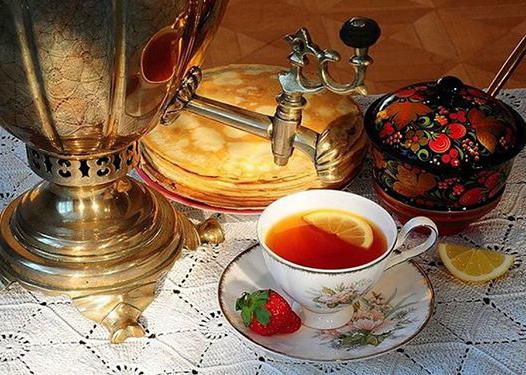
In Moscow, they drank initially black tea. Boiling water is heated in a samovar, and a teapot is placed on top. Tea leaves are made stronger than tea, which is eventually drunk. The tea leaves are poured into the cups, and after - boiling water from the samovar.
On the table for tea are always offered pastries,
lemon, sugar, jam and honey. The latter are eaten most often while drinking tea or smearing it on bread. Often served to the cup "tea pair" - a saucer. Hot tea from a cup is poured into it and drunk.
Whatever the tea traditions of different nations, everywhere this drink is valued for its pleasant taste, delicate aroma and unusual properties.
